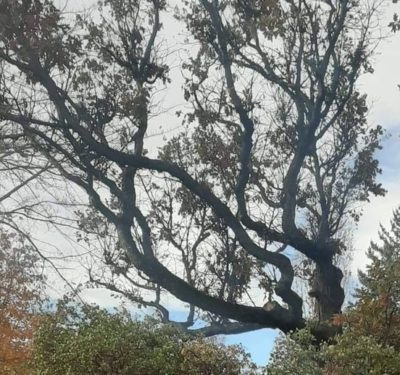This week I took our cooperativo to forage for Manzanita berries and acorns. We visited a lot in our neighborhood which appeared to be vacant. The children ran, explored and discovered beautiful oak galls, golden orbs with red speckles. They sampled the yummy manzanita berries but we decided not to harvest much because the tree had already been gleaned. So we delighted in the acorn bounty underfoot. Many acorns were left from the year before, so we felt we were not taking away from the animals. Soon enough, they were all mostly playing acorn games, doing exactly what children know to do on/with MamaTierra.
In the midst of this reverie, a woman whose home appeared to be next door with a fence around it, came out and started yelling “This is my property, you’re on private property!”
As soon as I heard her, I apologized, rallied the children and left the land. I understood her alarm and perspective, especially with the added layer of COVID.
AND when we returned home, I used it as a good moment to lightly talk about who MamaTierra actually belongs to. And explore what happens when people think they can own the land and keep it from others. It was important to give them an opportunity to process/debrief their experience. I shared that we and our ancestors view the land as our mother. And that our ancestors did not believe it made sense to sell and own portions of one’s mother. Mama Tierra es para todos. Mostly, I just elicited their wisdom, because they know the truth if we hold it for them.
The next day with my small social justice pod, my children and I shared this story and had a deeper conversation. We discussed the myth of Thanksgiving (see Lyla June’s beautiful video in comments), manifest destiny, the colonization of land and how we are still dealing with this today. We sat with the juxtaposition of the children’s joy on the land with the disconnection of the colonial mindset. Along these lines, we also shared that, even though our neighbors know that we are sheltering a family, we received a few complaints along the lines of “we pay too much property tax to have cars parked on the street.” Again, I understand this perspective because this colonialism is what we are all swimming in.
AND we discussed how the laws in the structures that we are living in, made by those with privilege and affluence keep us separate from each other. How in my trajectory from foster kid to suburbs, I was surprised to find that suburban folk tend to call the city or the cops on each other rather than converse. Separation. Individualism. And how so often I’ve felt more warmth and collaboration in low income neighborhoods where streets are thick with cars and people must work together to get by. I am grateful for these challenges that did break my heart, but offered excellent learning opportunities.
As I always do, I asked the youth what they think and what they see is possible, because they are closer to wholeness. They agreed that it is necessary to recognize the truth of our history of genocide, slavery and the ways colonial paradigms are STILL in charge. I shared about civil rights leader, Brian Stevenson’s call for truth and recognition as the essential step BEFORE reconciliation and healing can occur (and his museum designed for this purpose). Maya added that this concept facilitated healing after the Rwandan genocides. And many others. We will continue to steep ourselves in leadership that restores and remembers our full capacity. (I preserve the innate wisdom/connection to inner self now. The same that I help my adult clients reclaim)
Many resist looking at the truth because it’s uncomfortable, but I believe we ALL long for healing.
This week, may we honor the truth about the genocide, displacement and continued erasure of our native brothers and sisters. Knowing it is THE path to healing. May we keep reclaiming all of our humanity and learn from the children who show us. May we listen to our heart/spirit guidance on what loving action we can take. And as always, may all learning begin and end in gratitude.
